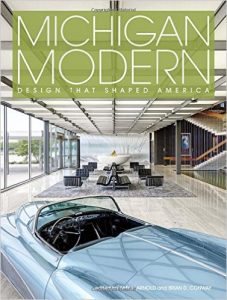Michigan Modern: Design that Shaped America
 In every way, this copiously illustrated book pleases and informs. Its editors have understood the mission, perfectly, to make a case for Michigan Modernism, not as a derivative response to ideas imported from elsewhere but as an original expression that “grew from the state’s indigenous industries and the populations they served.” (Alec Hess, Foreword) The proof comes by way of 28 essays and interviews presented in 4 categories of inquiry.
In every way, this copiously illustrated book pleases and informs. Its editors have understood the mission, perfectly, to make a case for Michigan Modernism, not as a derivative response to ideas imported from elsewhere but as an original expression that “grew from the state’s indigenous industries and the populations they served.” (Alec Hess, Foreword) The proof comes by way of 28 essays and interviews presented in 4 categories of inquiry.
The presence of such a wide range of topics derives from the scope of the project, elegantly explained by Brian D. Conway, State Historic Preservation Officer, in his Preface. What began as an effort to protect Modern buildings and resources in Michigan evolved into the development of a website (michiganmodern.com) and then a desire to inform the larger population, through museum exhibitions and symposia. The first stage was planned with Greg Wittkopp of the Cranbrook Art Museum and located at Cranbrook (June 2013). The second stage was hosted by the Grand Rapids Art Museum in partnership with Kendall College of Art and Design (June 2014). The exhibition of objects, models and photographs was expanded for the second show in Grand Rapids; photographs of both exhibitions appear in the book.
The SHIPO (State Historical Preservation Office) plan has now reached a moment of superb achievement with the publication of this book. A second filled with additional photographs is being planned. With these two flagship publications, the way is now open for the various localities–Detroit, Ann Arbor, Cranbrook and Grand Rapids–to pursue further an understanding of how modernism arose from within their indigenous cultures.
The 4 categories of inquiry will help direct further thinking and discovery: The Beginnings, Modernizing the American Lifestyle, Michigan Modern’s Architecture Legacy, and Michigan’s Influence. Further research might best address the category of influence, as we live now in the context of rich legacies of design (automobile, furniture, city planning and landscape) and architecture. The task ahead will involve the painstaking work of investigating the personal stories of so many remarkable and visionary designers as well as those who, one way or another, occasioned their designs.
There is no substitute for owning this book. At the least an individual topic and the photographs accompanying it will lift one up to a level of speculation, and in the right mood either enlist a sublime nostalgia or induce a feeling of transcendence. At their best these Michigan designs embrace revolutionary, utopian dream forms. The essays provide the necessary narrative infrastructures, and in every instance introduce new knowledge and eye opening insights.
The superior effort to document each photograph reinforces a positive first impression that this is a very serious book about a subject of high significance. And yet, the scrupulous documentation conveys a democratic theme: of a vast, shared but fragmented enterprise, carried forward with a delight in creative activity and with an intense desire to bring into being a better and more beautiful world. The best known players have now received shining attention in Michigan Modern, but there are many more to know about, and their contributions, too, in time will be brought to light.
Jeffrey Welch
Jeffrey is a member of the A2Modern Board of Directors. He is a retired teacher from Cranbrook Schools who also had the pleasure of residing on the Cranbrook property.
